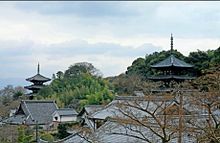Taima-dera
The Taima-dera ( Japanese 当 麻 寺 or 當 麻 寺 ) is a Buddhist temple in the south of the Japanese prefecture of Nara in the city of Katsuragi .
About history
According to tradition, the son of Emperor Yōmei , Prince Moroco ( 麻 呂 子 王 Moroco no Ō ), is said to have built the temple as Nijōsan Mampōzōin Zenrin-ji ( 二 上山 万 法 蔵 院 禅林 寺 ). According to this, in 692 the grandson Taima no Kunimi ( 當 麻 国 見 ), following a dream, moved the temple to its present location. Today it is more likely that the temple was built as a house temple of the Taima clan at the beginning of the Heian period .
The temple belonged to the Kofuku-ji in the Heian period and was largely destroyed in the course of the Gempei War in 1180 . After that it was rebuilt with the support of Minamoto no Yoritomo . At the beginning the temple followed the Sanron teaching ( 三 論 宗 ), but under the influence of Kōbō Daishi he took over the Shingon teaching , later also the Jōdo teaching ( 浄土 宗 ). With the saga of the Chūjō-hime and the mandala tapestry ( 綴 織 當 麻 曼荼羅 図 , Tsuzure-ori Taima Mandara-zu ) the temple became an important place of worship for the Jōdo believers.
The attachment
- One enters the temple, somewhat unusual, from the east through the Tōdai-mon (A), which is designed as a Rōmon and in which the temple guards, the Niō, are posted. The other buildings also face east.
- Next up is the bell tower (B).
- The main hall ( 金堂 Kondō ) and to the right of it (D) the teaching hall ( 講堂 Kōdō ) are arranged a little higher up next to each other (C )
- Behind it stands the mandala hall (( 曼荼羅 堂 Mandara-dō or 本 堂 hondō ) (E).
- To the left, in accordance with the usual arrangement of the temple buildings in the south, there are two three-story pagodas from the 8th century (O) and (W). This is the only temple complex in Japan that can boast two pagodas from the time it was built.
- In the west of the complex (G) joins the Oku-no-in ( 奥 之 院 ) in as a sub-temple ( 塔 頭 tatchū ) , which has a beautiful garden (H) next to the temple garden, which is known for its peonies.
- The Yakushi-dō (Y) is located in the northeast of the complex.
The mandala hall and the two pagodas are registered as national treasures of Japan , the main hall, teaching hall, the yakushi-do, the east gate, the bell tower and the like. a. Buildings as important cultural assets .
Cultural assets
( ⦿ = national treasure , ◎ = important cultural asset of Japan )
- The ⦿ bell ( 梵 鐘 bonshō ) is dated to the Hakuhō period , making it the oldest in Japan.
- A seated ⦿ Miroku Buddha ( 塑造 弥勒 仏 坐像 ) made of clay is venerated in the main hall . There are also the ◎ Four Kings of the Sky in dry lacquer finish and a wooden ◎ Kichijō-ten.
- A copy ( ◎ ) of the mandala tapestry can be viewed in the mandala hall . It dates from the Muromachi period and differs significantly from the very damaged original.
- In the training hall there are ◎ Amida Nyorai , ◎ Myōdō Bosatsu and ◎ Jizō Bosatsu made of wood.
Legend of the princess Chūjō-hime
Princess Chūjō-hime ( 中将 姫 ) is said to have been the daughter of Fujiwara no Toyonari ( 藤原 豊 成 ; 704–764), who was a minister in the Nara period . She is said to have fled to Taima-dera at the age of 16 for fear of her stepmother, where she was also called Hō'nyoni ( 法 如 尼 ). An old nun is said to have asked her to collect in the provinces of Yamato , Kawachi and Ōmi Lotus. She is said to have produced and dyed threads from the lotus stems. The old nun and a young one are said to have woven the carpet and then ascended westward into heaven. The princess realized that the two were Amida Nyorai and Kannon Bosatsu and proclaimed this story until the end of her life. - Another version says that the princess herself in one night the Nirvana - Mandala wove and was taken to Nirvana, where she lives today.
Temple festival
Every year on May 14th, the "Procession of the 25 Bodhisattvas " ( 当 麻 寺 二 十五 菩薩 来 迎 会 ) is held to celebrate Chūjō-hime, which was led by 25 Bodhisattvas in Buddha's Nirvana. Persons disguised as Bodhisattva carry a statue of the princess in a procession from the mandala hall to the (F) hall Shabadō ( 娑 波 堂 ) and from there back to the mandala hall to show the way from the world into nirvana.
gallery
Remarks
- ↑ The Yakushi-ji in Nara also has two pagodas in this arrangement, but the western pagoda was only rebuilt a few years ago.
- ↑ The original ( ⦿ ) is not publicly available.
swell
- Brochure Nara (English)
- Naraken rekishi gakkai (ed.): Nara-ken no rekishi sampo (ge). Yamakawa Shuppan, 1997, ISBN 978-4-634-29590-2 .
- Naraken kotogakko kyoka tokenkyukai rekishi bukai (ed.): Nara-ken no rekishi sampo (ge). Yamakawa Shuppan, 2007, ISBN 978-4-634-24829-8 .
Web links
- Official Website - Japanese
- Information offered by the Nara Prefecture ( Memento of September 27, 2007 in the Internet Archive ) - English
Coordinates: 34 ° 30 ′ 57.9 ″ N , 135 ° 41 ′ 40.7 ″ E








